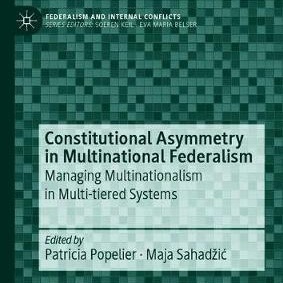Author Interview: Constitutional Asymmetry in Multinational Federalism
/Patricia Popelier & Maja Sahadzic
University of Antwerp
Tell us about the book
While constitutional asymmetry is an important feature of contemporary systems with federal arrangements, it remains an under-developed topic in comparative federalism. Admittedly, political asymmetry has been discussed in political science. Nevertheless, this field has neglected to establish an adequate link between political and constitutional asymmetries and to evaluate their effects and consequences for constitutional systems in which they appear. Adding to this, traditional federal theory has focused on “model” federal states such as Germany and the United States of America, ignoring new forms of systems with federal arrangements. At the same time, many contemporary systems with federal arrangements are multinational. Ultimately, this global unidimensional perspective risks giving a biased picture of state structures and federal dynamics, unable to respond to the challenges of contemporary fragmenting states.
Thus far, our knowledge related to the influence of constitutional asymmetries on systems with federal arrangements has remained scarce. This book aims at filling this gap by giving a legal but also a comprehensive account of constitutional asymmetry. It builds on a new approach of dynamic federalism, including systems all over the world, and enabling a comparative study of a phenomenon such as constitutional asymmetry that is not easily captured under traditional federal theory, which aspires symmetry for the sake of equality and stability. The book offers a set of 16 reports based on a template that includes comparative indicators and allows the testing of five hypotheses. It includes an analysis of multinational multi-tiered systems worldwide, covering 15 legal systems, many of which are often ignored in comparative federal and constitutional studies: Belgium, Bosnia and Herzegovina, Canada, China, Ethiopia, India, Indonesia, Iraq, Italy, Malaysia, Myanmar, Pakistan, Russia, Spain, and the United Kingdom. It also includes the European Union, thus widening the scope of research to include systems that do not identify with traditional scholarship.
What inspired you to take up this project?
Both of us as the editors of the volume have been personally or professionally linked to multinational systems that have changed their constitutional design over time to become systems with federal arrangements. Hence the profound interest in the topic.
Whose work was influential on you throughout the course of the project?
Bauböck’s assertion that constitutional asymmetry undermines equality, transparency and cohesion is at the root of the idea for the research project. Another trigger was Hombrado’s observation that while scholarship on asymmetrical federalism has been devoted to defining the concept and describing individual cases, the impact of different types of asymmetry on constitutional structures and dynamics has remained unexplored.
In the general run of things, the work of Ronald L. Watts and Michael Burgess was certainly vital for the outline of the project. However, in more explicit and specific terms, the work of Alain-G. Gagnon and his co-partners on the Canadian constitutional system as well as the work of Francesco Palermo on Italian regionalism inspired several hypotheses in the volume.
What challenges did you face in writing the book?
There were two challenges. The first was how to make sure that the authors in the volume follow the proposed template. Without this aspect covered, it would have been difficult to provide a comparative analysis. The second challenge was to make sure that all selected reports were written as we were aiming to have a comprehensive edited volume. To that end, we had to make sure to have a backup in case an author would decide to “surrender”.
What do you hope to see as the book’s contribution to academic discourse and to constitutional or public law more broadly?
Through the reports, the book aims at laying bare the close connection between constitutional asymmetries and sub-national identity, to the point that constitutional asymmetry is an inevitable feature of multi-tiered systems that are multinational in their essence. This would induce federalism scholars to rethink classic theory so as to fit in constitutional asymmetry instead of regarding it as deviations from the ideal of symmetry. This way, the book is also marked by its responsiveness to contemporary challenges of constitutional engineering in multinational states.
What’s next?
One of the co-editors is preparing a follow-up monograph, partially based on this edited volume. This book is part of a research project funded by the Flemish Fund for Scientific Research (FWO) that also involves a Ph.D. However, the Ph.D. is broader than the edited volume as it also involves a comparative analysis of multinational and non-multinational systems to find whether asymmetry is mainly linked to multinational multi-tiered systems. It uses the qualitative comparative analysis (QCA) method to identify the factors that stimulate constitutional asymmetry. It also examines at which point constitutional asymmetry poses a risk for the legitimacy and stability of multinational systems with asymmetrical constitutional solutions.


